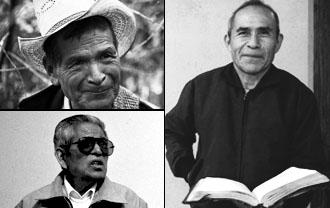Evangelical Christianity on the rise in Catholic Mexico
Juvencio Domingo, pictured top left, of Zongozotla said “we were born Catholics but we changed.” (Photo courtesy of PRI’s the World).
In heavily Catholic Mexico, evangelical Christianity is on the rise.
In 1970, according to census figures, 96 percent of Mexicans claimed to be Catholics, but that figure had dropped to about 80 percent by 2010. Evangelicals are filling part of that spiritual gap.
One place to see the change is the Mexican town of Zongozotla, tucked in the highlands of the central state of Puebla. As you make your way up the winding road to town, the colonial Catholic Church still dominates the landscape — but it’s the only Catholic Church there. There are more than 12 others places of worship, including Pentecostal, Jehovah’s Witness, Baptist and other faiths.
Evangelical preacher Miguel Ponce said, before the arrival of the evangelicals, the town of Zongozotla “lived under a curse.”
“All of our ancestors lived in disgrace, with alcohol, with witchcraft. People never prospered,” Ponce said.
American Southern Baptist missionaries began conversions in the town in the 1950s. It then became a Mexican-led movement, and the number of converts increased as stories of drastic life changes spread.
Juvencio Domingo, a 74-year-old coffee farmer, turned to religion when he was in his 30s and, he said, lost in an alcoholic haze.
“My sons and daughters didn’t eat well and I drank alcohol,” Domingo said.
Domingo said the Catholic Church failed him.
“They don’t advise you well,” he said. “The priest never tells you, ‘stop drinking.’ That’s wrong.”
Domingo said the evangelical religion has served him better.
“Because they explain things well, that life is worth something. And if you don’t take care of your life, whose fault is it? Ours,” said Domingo.
Today, evangelicals outnumber Catholics in the town, and it’s places like this, along with evangelical mega-churches in cities that test Catholic dominance. Mexico is still the second-largest Catholic country though, behind Brazil, at least in raw numbers.
Anthropologist and religious expert Elío Masferrer said in rural villages like Zongozotla, evangelicals appeal on the economic front. Compared to evangelicalism, Catholicism demands costly baptisms and church weddings that can drain a family’s savings.
“It’s expensive to be Catholic,” Masferrer said. “You have to understand that converting makes economic sense.”
In Zongozotla, Father Lazaro Salgado is the Catholic priest. Like other Catholic priests facing tough competition, Salgado has livened up his mass with more singing and preaching in the local, indigenous Totonaco language.
“I think that our work is about being present, spending less time in the office, sitting, and not feeling somewhat superior,” Saldago said. “If not, who will people go to? The church that embraces them, advises them.”
But more than anything, Salgado is also overstretched. He does not live in Zongozotla. It’s just one of nine villages he rushes through on Sundays. Evangelical preachers outnumber him.
Surveys have found an average of one Catholic priest for every 6,000 Catholics in Mexico, compared to one evangelical pastor for every 200 followers. In Zongozotla, all of the evangelical pastors live in town, have families there and offer services throughout the week.
It was once unheard of in Mexico to consider not being Catholic. But in Zongozotla, where different faiths are gaining ground, spiritual shifts are possible — and underway.
Conversion: A Mexican Village’s Evangelical Shift from PRI’s The World on Vimeo.
